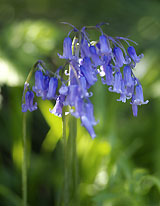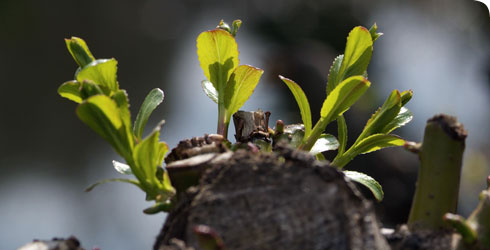Woodland
Woodland once covered most of Britain but it now covers less than 12% of the land. Lowland woodland includes native trees such as pedunculate oak (Quercus robur), ash (Fraxinus excelsior) and silver birch (Betula pendula) with woodland flowers such as primrose (Primula vulgaris) and wood anemone (Anemone nemorosa), and mosses on the forest floor.
History
Since Neolithic times, around 5000 years ago, woodland has been cleared to make space for agriculture, villages and towns. It has also been managed and harvested for fuel, food, fencing and building materials.
Britain was once a predominantly wooded country and woods continue to be an important feature of our landscape and cultural history.
Features

Bluebells (Hyacinthoides non-scripta) in the Wildlife Garden
Different layers of plants can be seen in mixed native woodland: the tall tree canopy, the shrub layer, field layer and ground layer. Each contains different species:
Tall tree canopy Oak, ash and silver birch support many insects, birds, lichens, mosses and fungi.
Shrub layer Small trees such as hazel (Corylus avellana), hawthorn (Crataegus monogyna), buckthorn (Rhamnus cathartica) and guelder rose (Viburnum opulus) provide cover and food for nesting birds, small mammals, insects and other invertebrates.
Field layer Woodland flowers such as bluebell (Hyacinthoides non-scripta), primrose and wood anemone, woodland grasses such as wood melick (Melica uniflora) and wood millet (Millium effusum), and sedges such as pendulous sedge (Carex pendula) and wood sedge (Carex sylvatica) all support smaller animals, bees, butterflies and other insects.
Ground layer Mosses, liverworts and seedlings support small invertebrates in abundance. Fallen and decaying wood and leaf litter are also important for hundreds of species of ground living insects, other invertebrates and fungi.
These different layers may not be obvious in all woods. Some woods, for example, are dominated by a dense tall tree canopy which stops light from reaching lower layers and reduces the number of species of plants and animals living there.
The composition and structure of our woods also varies according to age, soil type, climate and landform.
For example, woodland in damp or water-logged areas such as the Norfolk Broads is dominated by alder (Alnus glutinosa) and willow (Salix) species. The field layer includes sedges, cuckooflower (Cardamine pratensis) and marsh marigold (Caltha palustris).
On upland areas with acid soil, woods are dominated by sessile oak (Quercus petraea) and downy birch (Betula pubescens) along with wood sorrel (Oxalis acetose), foxglove (Digitalis purpurea) and bluebell.
Habitat for wildlife
Woods provide many different habitats for wildlife. A number of factors affect the quantity and diversity of insects and animals you can find in a wood. These include:
- size of the woodland area
- water resources
- age of the wood
- management
- structure
- number of plant species
Ancient woodland has greater wildlife value than woodland that has been planted more recently, so a larger number of species of plants and animals live there.
Managed woodland such as hazel coppice also provides more opportunities for wildlife than dense conifer plantations, see section on managing woodland.
Habitat loss
As the demand for woodland products has fallen over the years, much of Britain's woodland has been neglected. Derelict coppices have grown up and shaded the field layer, reducing the number of plant species that so many butterflies and other insects depend on. This has had a negative effect on woodland biodiversity.
Large areas of woodland have also been cleared to make way for agriculture and urban expansion. Motorways and towns often sprawl across areas where woods once grew.
Today, with just under 12% of land under woodland cover, the UK is one of the least wooded countries in Europe.
Managing woodland
The diversity of structure and opportunities for wildlife habitats in our woodlands is maintained by traditional woodland management techniques.
One method - coppicing - was once commonly practiced in Britain. Small trees or shrubs such as hazel and sweet chestnut (Castanea sativa) were cut to their base and the wood was harvested. The trees were then left to grow for a few years until the stems were large enough for cutting again.
In each woodland, areas of trees were coppiced in stages. Traditionally coppiced woodland was made up of a number of different compartments of hazel or sweet chestnut at different stages of growth. While the trees in one compartment were left to regenerate, those in the adjoining compartment were coppiced.
This process opens up large areas of woodland in rotation, providing light that encourages woodland flowers. These include primroses, bluebells and wood anemone which in turn benefits many insects. In this way coppicing provides a sustainable source of wood. It also offers a managed structure for the different habitats so that a wide range of species can flourish.
Conservation organisations are reviving coppice management in many parts of the country.
Woodland in the Museum's Wildlife Garden
In the woodland areas of the Wildlife Garden you will see some of the trees and other plants commonly found in mixed deciduous woodland in lowland Britain. Species include:
- pedunculate oak
- silver birch
- field maple (Acer campestre)
- ash
- hazel
- hawthorn
- primroses
- wild garlic (Allium ursinum)
- bluebells
- dog's mercury (Mercurialis perennis)
Our hazel is coppiced and the harvested wood is used to make wood piles or fencing around the garden's meadow areas to contain our sheep in late summer.
In the sunlit woodland glades there are also plenty of birds and insects to be found. These include:
- holly blue butterflies (Celastrina argiolus) in the spring
- speckled wood (Pararge aegeria) butterflies in late spring and summer
- wrens (Troglodytes troglodytes) and robins (Erithacus rubecula) nesting in the hawthorn
- blackbirds (Turdus merula) feeding on rowan berries in August
- many species of bees and wasps foraging in the spring and summer
Woodland in your garden
Woodland trees may be too large for your garden but you can still encourage biodiversity by creating different layers of plants. Even in small gardens a variety of small trees, shrub or climbing plants can be grown to complement lawns and flower beds. Many varieties of shrubs may be coppiced. A pile of logs or stack of leaves in a shady corner will provide a refuge for beetles, woodlice, toads or hedgehogs.
Wildlife Garden blog

Keep up to date with what’s happening in the Museum’s Wildlife Garden and discover some of the latest sightings in this tranquil haven.


